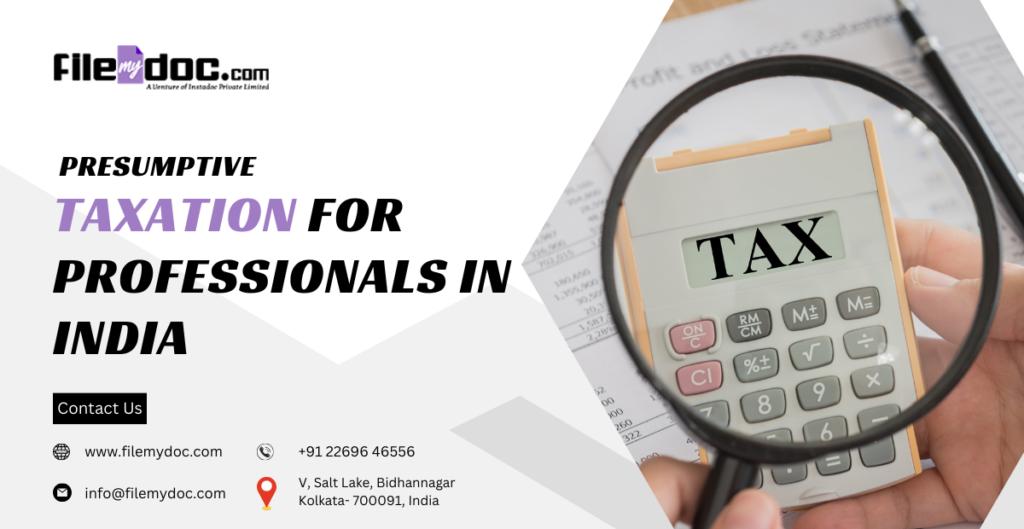Understanding Presumptive Taxation for Professionals in India
Presumptive taxation is a simplified tax scheme introduced by the Indian government to ease the compliance burden on small taxpayers. This guide delves into the specifics of presumptive taxation for professionals, its benefits, eligibility criteria, and the filing process.




What is Presumptive Taxation?
Simplified Tax Scheme
Presumptive taxation allows professionals to declare their income at a prescribed rate, eliminating the need to maintain detailed books of accounts. This scheme is designed to streamline tax filing and reduce the administrative burden for small taxpayers.
Applicable Sections
The scheme for professionals falls under Section 44ADA of the Income Tax Act. This section is specifically tailored to cater to individuals in professions such as legal, medical, engineering, architectural, accountancy, technical consultancy, and interior decoration, among others.
Eligibility Criteria
Who Can Opt for Presumptive Taxation?
Professionals with gross receipts not exceeding ₹50 lakh in a financial year are eligible to opt for the presumptive taxation scheme under Section 44ADA. This threshold ensures that the scheme benefits small and medium-sized professional practices.
Exclusions
Certain individuals and entities are excluded from this scheme, including those claiming deductions under specific sections of the Income Tax Act or professionals with gross receipts exceeding the ₹50 lakh threshold.
Benefits of Presumptive Taxation
Simplified Compliance
One of the primary advantages of presumptive taxation is the simplified compliance process. Professionals are not required to maintain detailed books of accounts or undergo audits, making tax filing more straightforward.
Reduced Tax Liability
Under presumptive taxation, professionals can declare 50% of their gross receipts as their deemed income. This deemed income is then subject to tax, potentially resulting in a lower tax liability compared to the actual income.
Ease of Filing
The ease of filing is another significant benefit. Professionals can use the simplified ITR-4 form for their tax returns, which requires less documentation and is easier to complete than other forms.
Calculating Income under Presumptive Taxation
Deemed Income
For professionals opting for Section 44ADA, 50% of the total gross receipts or turnover is considered as deemed income. This means that half of the receipts are treated as the taxable income for the year, simplifying the calculation process.
Example Calculation
For instance, if a professional earns ₹40 lakh in a financial year, ₹20 lakh (50% of ₹40 lakh) will be considered as the deemed income. This amount will be subject to tax according to the applicable income tax rates.
Filing Process
Required Forms
Professionals opting for the presumptive taxation scheme must file their returns using ITR-4. This form is specifically designed for individuals and HUFs (Hindu Undivided Families) opting for the presumptive taxation scheme under Sections 44AD, 44ADA, and 44AE.
Due Dates
The due date for filing tax returns under the presumptive taxation scheme is typically the 31st of July following the end of the financial year. However, it is essential to stay updated with any changes in deadlines announced by the Income Tax Department.
Advance Tax Payments
Professionals under this scheme are also required to pay advance tax if their total tax liability for the year exceeds ₹10,000. This advance tax can be paid in a single installment by the 15th of March of the financial year.
Record Keeping and Documentation
Simplified Record Keeping
While detailed books of accounts are not required, professionals should still maintain basic records of their gross receipts and expenses. This documentation will be helpful in case of any inquiries from the Income Tax Department.
Proof of Receipts
Maintaining proofs of all receipts and payments is crucial. These records will support the declared income and can be used to resolve any discrepancies or queries during the assessment.
Transitioning from Regular to Presumptive Taxation
Switching Schemes
Professionals can switch from regular taxation to presumptive taxation and vice versa. However, if a professional opts out of the presumptive taxation scheme, they cannot re-enter it for the next five financial years.
Impact on Audit Requirements
Switching back to regular taxation means professionals will need to maintain detailed books of accounts and may be subject to audit requirements if their gross receipts exceed the specified limits.
Conclusion
Presumptive taxation under Section 44ADA offers significant benefits to small and medium-sized professionals in India. By simplifying the compliance process, reducing the tax liability, and easing the filing process, this scheme provides a practical and efficient way for professionals to manage their taxes. Understanding the eligibility criteria, benefits, and filing requirements is essential for making the most of this advantageous tax scheme.


























